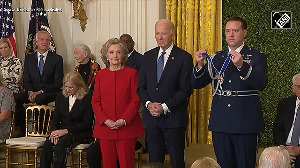Rajesh Saxena, CEO, American Express Banking Corp, India, recently moved from Citibank in Japan to become the chief executive of American Express Banking Corp, India.
Saxena started his career with Hindustan Unilever and has spent 18 years in consumer and retail banking in five different geographies: India, Israel, Turkey, the UAE and Japan.
He was a part of the core Citibank team when it launched credit cards in India in the early-1990s.
The market today is different. Delinquencies are on the rise, consumers are spending less. Saxena tells Business Standard's Bhupesh Bhandari how he is fine-tuning American Express' credit card strategy.
These are tough times for the credit card business. The slowdown has impacted the business. If you look at the market, delinquencies are higher than in the past. If you go deep, you will find that there is a segment of customers which has been temporarily impacted by the liquidity crisis.
And that is what we have to work on. Maybe in the last couple of years the industry went a little overboard in the way we were giving cards. Now, with the bureau (Credit Information Bureau (India) Ltd) coming up, this is probably a clean up. In a couple of months or quarters, the industry will come out stronger.
What we follow at American Express is the spend-centric business model. What it means is that we are looking at acquiring customers where spend is the key. From the American Express perspective, we are looking at customers who probably have a household income of over Rs 800,000 per annum.
What clean up are you doing at American Express?
We are not really impacted. But what we are leveraging is the good information available on the bureau. We want to ensure that in all our risk decisions, we leverage this information as much as possible.
Have you weeded out any customer?We charge an annual fee on our card starting from Rs 3,100. So we don't have the problem of card holders not spending. Fee helps in driving spend on cards.
How does spend on American Express cards compare with others?
It is five times the industry average. What is interesting is our numbers (card spends) are comparable to American Express cards in developed markets like the US, UK or Japan.
Average card spend is down 5 per cent in the last one year. How is it for American Express?
If you look at the industry, spend went down 10 per cent in February. At American Express, we grew in the first quarter of 2009. We are continuously outperforming our peers and gaining market share.
While some companies look at market share in terms of cards, we look at it in terms of sales or billing.
As we look at the market today, what we see is that there is some slowdown in discretionary spending and we are also seeing some down-trading. On everyday spending, we continue to see strong customer engagement - the number of times the customer transacts.
In March, our customer engagement was more than in February.
Another area where we are seeing a slowdown is overseas spending. Clearly, our customers are travelling less. This is where we have been impacted.Are these issues you can address?
If we try to increase the discretionary spend, it will go against the grain of the market. So, it is not the right time to expand on discretionary spending. We would rather put more marketing dollars on increasing our everyday spend.
Recently, we tied up with Life Insurance Corporation, PVR and so on. We are focusing more on the daily life.
What is your market share in cards and in total card billings?
According to our information, there are about 25 million cards in force. And if you look at unique customers, they are less than 10 million. So, we would be fraction of the market. From a billed perspective, we are in double digits. It is disproportionate to our share of cards. It is six or seven times.
Does the 20:80 rule apply in credit cards too - 20 per cent of the customers account for 80 per cent of the business?
It is normal to see some high spenders at the top end. It would be more towards 35:65 or 40:60. There would always be some concentration of high spenders.
Do you have card holders who do not spend?
The proportion is very small. The value we offer will resonate only when you spend on the card. Otherwise why would you pay a fee of at least Rs 3,100 per annum? This is not a problem we face.
What is the cost of carrying cards on which there is no spend?
There is the cost of plastic and the features that you buy from some providers. It could be anywhere between $5 and $10-15 per annum. A couple of years ago, the industry may have given many cards to one person. You know today on the bureau exactly the credit lines a customer has. Any clean up needs to be done from that perspective.
What kind of data mining do you do these days to select customers?
We believe income may be a very crude surrogate of actual spending. For example, we look at the Airtel database and see how many people are on roaming. That gives us a good idea who is spending over Rs 2,500 on a monthly basis. Then we tell them why don't they put their Airtel bill on a standing instruction with us?
We give 10 times the rewards points. We test the downstream behaviour six months down the road. And then we revalidate whether the model works. If it doesn't, what is it that needs to be fine-tuned?
How is your corporate cards business doing?
If you look at our corporate card, we have a strong value proposition on managing the whole T&E (travel and entertainment) side. A lot of companies are cutting back on their travel. So, we are seeing some temporary impact on our corporate card portfolio.
In new corporate cards we are seeing aggressive acquisition. A lot of companies realise that by taking an American Express corporate card they can save money. In good times, nobody used to focus on it. But in these bad times, all CFOs are looking at how to manage better their T&E budgets. In the last three or four months, we have been able to get more corporate card customers.
We are seeing that the spending of existing corporate clients is coming down. So we are really focusing on is how do we get new accounts. We are seeing that multinational corporations are more impacted than the Indian companies. So we are focusing more on Indian companies. That's how we are fine-tuning our strategy.
Your merchant discount rates are higher than the industry average.
Our numbers are on the higher side and this is because we are able to drive value. The merchant is able to see value in our card holders because of their higher spend. We find that a lot of our card members like to spend on weekends. So we have a programme called Extraordinary Weekends.
If you go to any retail shop or any restaurant which is not in a five-star hotel on a Friday, Saturday or Sunday, we offer you five times the rewards points.
Do you have 100 per cent merchant coverage for your card holders?
It is 85 per cent.How is your corporate travel business doing?
Corporate travel is down. What is interesting is that earlier travel decisions were made by people in administration or the human resources department. That has now become a CFO decision. And if you go to them with a value proposition, we find that we are able to attract a lot more new customers.
Our model can offer 20-25 per cent savings. Earlier it was difficult to sell. Now we find that it is a good time to acquire new customers.






 © 2025 Rediff.com -
© 2025 Rediff.com -